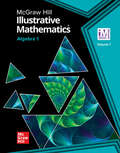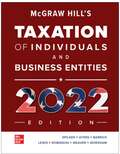- Table View
- List View
McDougal, Littell English Literature: American Literature, Green Level
by Gail A. Dristle Luann W. GlickMcDougal, Littell Literature, Green Level, contains unadapted, uncut selections that represent the finest traditional and contemporary literature.
McGraw Hill Ciencias (Grade #1)
by Lucy Daniel Joanne Vasquez Jay Hackett Richard Moyer Prentice Baptiste Pamele StrykerSpanish text book Science
McGraw Hill Illustrative Mathematics®: Algebra 1, Volume 1
by McGraw-Hill EducationNIMAC-sourced textbook <p>Grade Level 9</p>
McGraw Hill Mathematics 5th Grade
by MacMillan/McGraw-Hill StaffTopics covered in this book are: place value, whole numbers, decimals, data, statistics, graphs, number theory, fraction concepts, measurement, integers, geometry, algebra, ratio, probability and percents.
McGraw Hill Reading
by Barbara Coulter Frankie Dungan Joseph B. Rubin Carl B. Smith Shirley WrightA reading textbook for children.
McGraw Hill Science (Grade 1, Tennessee Edition)
by Richard H. Moyer Joanne Vasquez Jay Hackett Pamela Stryker Prentice Baptiste Lucy H. DanielThis book covers science in three units: life science, earth science and physical science.
McGraw Hill Science (Tennessee Edition)
by Richard H. Moyer Jay Hackett Lucy H. Daniel H. Prentice Baptiste [et al.]An edition that instills scientific knowledge on its readers in an interesting yet knowledgeable way; you will learn many new words that means new ideas with image descriptions that will help you understand what you are reading.
McGraw Hill Science 3rd Grade
by Lucy Daniel Joanne Vasquez Jay Hackett Richard Moyer Pamela Stryker H. Prentice BaptisteGeneral science textbook.
McGraw Hill Science, Grade 4
by National Geographic Society Macmillan Mcgraw-HillThis grade4 science covers lessons on 1. Life Science: The World of Living Things; Animals as Living Things, 2.Earth Science: Earth and Beyond; Water and Weather, 3.Physical Science: Matter; and Energy.
McGraw Hill Science: Grade 2
by Mcgraw HillThe three major topics covered in this book are Life, Earth and Physical Science.
McGraw Hill's Taxation of Individuals and Business Entities 2022 Edition
by John Robinson Connie Weaver Brian Spilker Benjamin Ayers John Barrick Troy Lewis Ronald WorshamThe bold and innovative McGraw-Hill Taxation series is now the most widely adopted code-based Tax title across the country. It’s apparent why the clear, organized, and engaging delivery of content, paired with the most current and robust tax code updates, is used by more than 600schools. <p><p> The breadth of the topical coverage, the storyline approach to presenting the material, the emphasis on the tax and non-tax consequences of multiple parties involved in transactions, and the integration of financial and tax accounting topics make this book ideal for the modern tax curriculum. <p><p> Story line Approach: Chapters introduce a set of characters facing specific tax-related situations with a conversational writing style, organization, and real-world focus <p><p> Integrated Examples: "What if" scenarios to illustrate how variations in the facts might/might not change the answers. <p><p> 100+ Videos: Provide students with on-demand walk-throughs of key Tax topics.
McGraw- Hill Science
by Lucy Daniel Joanne Vasquez Jay Hackett Richard Moyer Pamela Stryker H. Prentice BaptisteLearn more about what scientists do, and how you can explore the world through science yourself!
McGraw-Hill Ciencias (Grade 2, Edicion para Texas)
by Lucy Daniel Joanne Vasquez Jay Hackett Richard Moyer Pamela Stryker Prentice BabtisteA Spanish Science textbook.
McGraw-Hill Ciencias (Grade 4, Edicion para Texas)
by Lucy Daniel Joanne Vasquez Jay Hackett Richard Moyer Pamela Stryker Prentice BabtisteSpanish science textbook.
McGraw-Hill Education TASC - Test Accessing Secondary Completion
by Kathy A. ZahlerIt's packed with everything you need to succeed on the test---and get the high school credential you want. Only this guide can show you exactly what to expect on the test, tell you how the test is scored, and give you authentic TASC questions for practice. That makes this bestselling guide your most reliable and accurate source for everything you need to know about the TASC.
McGraw-Hill English (Level #8)
by James Elizabeth Marvin William Hoffman Klein Sulzby TealeEnglish Textbook.
McGraw-Hill Illustrative Mathematics®: Algebra 1, Volume 2 (Illustrative Math Algebra 1)
by McGraw HillNIMAC-sourced textbook



